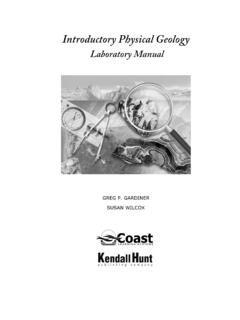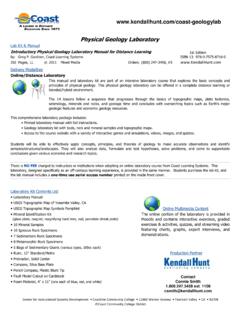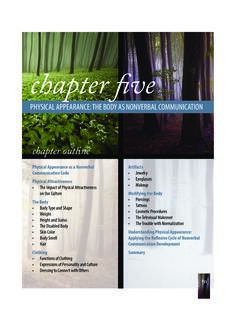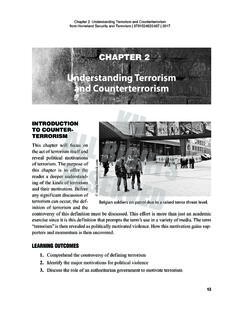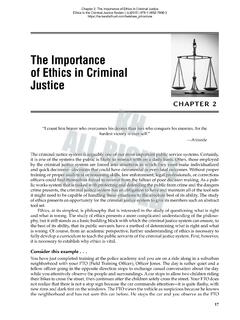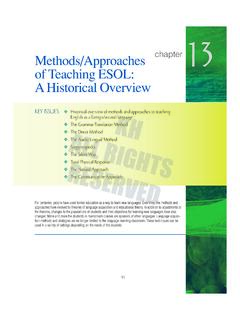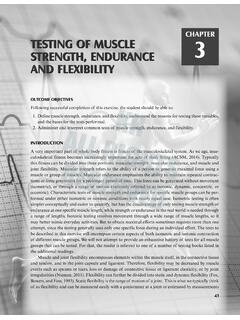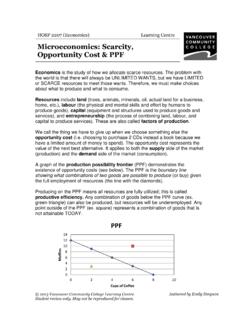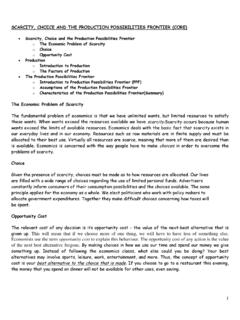Transcription of Chapter
1 23 Chapter 2 production Possibility CurvesObjectives 1. To define the implications of scarcity in an economic system. 2. To define the meaning of production possibility curves. 3. To understand the economic implication of the production possibility curve model. 4. To discuss the economic importance of the law of increasing opportu-nity cost. 5. To understand the application of a production possibility curve in the business 2313/04/16 9:23 am24 EConomiCs Principles and ApplicationsBecause of scarcity , certain economic questions must be answered regardless of the level of affluence of a society or its political structure.
2 Some of the basic questions that an economy faces include the follow-ing: (1) What and how much should we produce? (2) How will we produce these goods and services? (3) Who will get the goods and ser-vices we produce? (4) How can we use our scarce resources efficiently? (5) Will current sacrifices necessary for more rapid economic growth be worth the gains that growth will offer future generations? These questions are unavoidable under the circumstances of order to decide what to produce and in what quantities, we use a simple model called a production possibility curve. This model illus-trates an economy s potential for allocating its limited resources to producing various combinations of Possibility Curves (PPC)A production possibility curve is a curve showing possible combina-tions of goods that an economy can produce given a fixed amount of resources, fixed technology, and efficient use of these us assume that the United States produces only two goods: food and clothing.
3 This is one way of simplifying, and it shows how an economy can divide the different modes of production . If we classify the modes of production between different countries, we can separate them into two groups. Either they are producing agricultural products or manufacturing products. Third-world countries generally produce agricultural products. One reason for the focus on agricultural prod-ucts is a more labor-intensive factor of production . On the other hand, first-world countries generally produce manufacturing products. Most first-world countries are abundant with capital resources. Therefore, it is more efficient for first-world countries to produce capital that the United States is given the following production pos-sibility schedule:XZPointFoodClothingA500 the points, we have a nonlinear curve called a production possibility curve. The shape of the curve is concave from the point 2413/04/16 9:23 am production Possibility Curves 25of origin.
4 As long as the economy is producing along the curve, we consider each production combination to be efficient. By efficient, we mean that the production mix is such that it is maximizing all the resources available in the economy. If we have a point, say point X, which is inside the production possibility curve, then we consider this point as inefficient. One implication of such a point is that the economy is under-employing its resources. For example, if the United States is producing 30 units of food and 2 units of clothing, it can produce an additional unit of food or clothing without losing any production of either good. Points, such as point Z, which are outside of the produc-tion possibility curve, are considered unattainable. This point is unat-tainable because the United States does not have resources to produce both 40 units of food and 4 of summary, as long as the economy produces along the curve, the econ-omy is maximizing its resources.
5 It is important to maximize resources because goods are being produced most efficiently. However, as we move along the curve, there is a cost in obtaining more of one commod-ity relative to another that is, as we move along the curve, the cost involved is relative to how much we give up of the other good. The cost related to movement along the production possibility curve is what we call an opportunity cost. An opportunity cost is the benefits we forgo for the best alternative resource. In our model, it is what we give up in order to gain some other goods that we wanted to acquire. For example, if the United States is currently producing 50 units of food and 0 cloth-ing (point A) and wishes to produce 2 more units of clothing (point B), it must give up 10 units of food. In order to calculate opportunity cost for clothing, we divide the loss of food by the gain of clothing.
6 In our exam-ple we will divide 10 (loss of food) by 2 (gain in clothing), which will give us 5. This means for every one clothing we gain, we lose 10 fact that the production possibility curve is concave from the point of origin, implies that it follows the law of increasing opportunity cost. The law of increasing opportunity cost states that as we gain more of one commodity, we have to give up more of the other commodity. It also implies that there is always a cost in doing something put, opportunity cost is the cost of gaining one commodity relative to another commodity. The concept of opportunity cost can be applied in many contexts. A good example can be the time spent in studying economics. At this point in time, you could be working or watching TV instead of reading your economics textbook. The cost of reading your economics book can be the time not spent elsewhere.
7 One basic assumption in the concept of opportunity cost is the fact that there is always a trade-off in doing CostThe concept of opportunity cost is one of the most important topics in economics. As previously defined, it is the benefits we forgo for 2513/04/16 9:23 am26 EConomiCs Principles and Applicationsthe best alternative resource. In any decision-making process, there will always be some cost involved. For example, a working person can choose between staying at home with the family or working full time. Given the time constraint, the working person can only do so much, so must choose between time spent with the family and full-time work. If he or she chooses to work, the opportunity cost involved is the fore-gone time spent with the family. If the working person chooses to stay at home to be with the family, the opportunity cost is the foregone time spent building a successful people allocate their resources properly in order to maxi-mize production or choices in life.
8 However, not everyone allocates resources properly given whatever constraints they may face. As an example, if a student spends more time partying instead of studying during a semester, the probability of failing the course is much higher. If the student fails the course, his or her opportunity cost is the wasted time spent in attending this particular Trade-offs Apply from a management Point of ViewTrade-offs giving up something in order to get something else are the mother of all opportunity costs. They lay at the heart of the execu-tive s job. And they are something of a paradox. The more successful you are, the greater the opportunity costs you face. In fact, success is measured by how well executives handle trade-offs, the very thing that haunts and torments executive faces two tasks. First up is to work with courage, skill, perseverance, and creativity to create trade-offs where none presently exist.
9 If you face no trade-offs, then your company is poorly managed. If you don t have to settle for less of one thing to get more of another, then it follows that you could have more of everything if you just man-aged or organized your affairs better. That, in turn, means that there is much fat and slack in the system that needs to be eliminated. Second up is to manage those trade-offs in the best possible way, balancing gain and pain in a manner that leaves your business best off, with the most gain for the least trade-offs can involve painful decisions about other peo-ple s lives, and can require rapid changes in perspectives and ways of thinking. Consider, as an example, the once-vaunted Japanese effi-ciency. As a matter of management policy Japanese firms have been reluctant to lay off workers during hard times. They have traded the inflexibility of lifetime employment for the greater loyalty and moti-vation it creates.
10 As a result, by one estimate Japanese companies cur-rently harbor a million hidden unemployed meaning workers who add nothing to company output but nonetheless draw pay. Many of 2613/04/16 9:23 am production Possibility Curves 27those million workers are in Japan s least-efficient sectors: banking, finance, and real estate. Some are in management jobs and are called madogiwa-zoku those who stare out the previous example of the production possibility schedule illustrates trade-offs. In order to gain more food, the United States must give up clothing and vice versa. This exists because resources are limited. Decisions need to be made for how these resources are allocated. If no trade-offs exist, then the United States is operating below the production possibilities curve, which is considered to be inefficient.
